Panicle Hydrangea Hydrangea paniculata 'Floribunda'
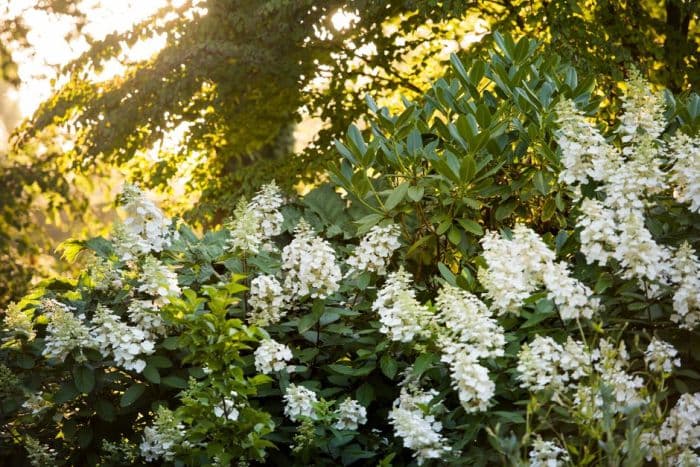
ABOUT
The Hydrangea paniculata 'Floribunda', commonly known as the panicle hydrangea, is characterized by its distinctive floral display and foliage. This plant boasts conical flower clusters that start out a creamy white and gradually turn to shades of pink as they mature, giving it a two-toned appearance during the blooming season. These large blooms are striking and dense, creating a full, lush look on the plant. The leaves of the panicle hydrangea are dark green, oval-shaped, and have serrated edges, which provide a beautiful backdrop to the impressive, elongated flower heads. Its stems are sturdy, helping to support the weight of the abundant flowers. Overall, the panicle hydrangea 'Floribunda' presents a showy and robust appearance, with its plentiful blooms and attractive green foliage, making it a popular choice for ornamental gardening.
About this plant
 Names
NamesFamily
Hydrangeaceae
Synonyms
Panicled Hydrangea, Panicle Hydrangea, Peegee Hydrangea
Common names
Hydrangea paniculata 'Floribunda'.
 Toxicity
ToxicityTo humans
Panicled hydrangea (Hydrangea paniculata 'Floribunda') contains compounds that can be toxic if ingested by humans. These include cyanogenic glycosides, which can release cyanide into the body. Consumption of large quantities of plant material, particularly leaves or buds, might result in symptoms such as nausea, vomiting, stomach pain, diarrhea, and sweating. In severe cases, dizziness, confusion, increased heart rate, and convulsions could occur. Cyanide interferes with the body's ability to use oxygen, which can potentially lead to fatal respiratory failure if a significant amount is ingested. However, accidental poisoning is rare and typically requires ingesting a considerable amount of plant material.
To pets
Panicled hydrangea (Hydrangea paniculata 'Floribunda') is also toxic to pets such as cats, dogs, and horses. This is due to the same cyanogenic glycosides found within the plant that affect humans. If pets ingest parts of the panicled hydrangea, they might experience symptoms such as vomiting, diarrhea, lethargy, depression, and in some cases, more serious symptoms like cyanosis (blueish discoloration of the mucous membranes due to lack of oxygen), difficulty breathing, and increased heart rate. In extreme cases, seizures and coma could ensue, potentially leading to death if a substantial amount is ingested. Pet owners should prevent access to these plants to avoid possible poisoning.
 Characteristics
CharacteristicsLife cycle
Perennials
Foliage type
Deciduous
Color of leaves
Green
Flower color
White
Height
6-8 feet (1.8-2.4 meters)
Spread
6-8 feet (1.8-2.4 meters)
Plant type
Shrub
Hardiness zones
3-8
Native area
Asia
Benefits
 General Benefits
General Benefits- Aesthetic Appeal: Hydrangea paniculata 'Floribunda', commonly known as Panicled Hydrangea, features large, showy flower clusters that can add dramatic beauty to gardens and landscapes.
- Variability in Color: The blooms can change color depending on soil pH, which allows for a variety of hues within the same plant, creating a visually appealing display.
- Seasonal Interest: This plant blooms in the summer and its flowers often last into the fall, providing a long season of visual interest.
- Attracts Pollinators: The flowers are attractive to pollinators such as bees and butterflies, supporting local ecosystems.
- Adaptable to Various Soils: Panicled Hydrangea can adapt to a range of soil types, though it prefers well-drained, moist soils.
- Hardiness: It is a hardy plant that can tolerate cold temperatures, suitable for a variety of climates.
- Easy to Care For: This hydrangea is relatively low maintenance, requiring minimal pruning and care once established.
- Versatility in Landscaping: It can be used as a standalone accent plant, grouped in a border, or as part of a foundation planting, offering versatility in landscape design.
- Works as a Cut Flower: The blooms make excellent cut flowers for arrangements, lasting well in a vase.
 Medical Properties
Medical Properties- This plant is not used for medical purposes.
 Air-purifying Qualities
Air-purifying QualitiesThis plant is not specifically known for air purifying qualities.
 Other Uses
Other Uses- Hydrangea paniculata 'Floribunda', commonly known as Panicled Hydrangea, can be used for cut flowers in floral arrangements due to its showy and long-lasting flowers.
- Dried flower arrangements often incorporate Panicled Hydrangea blooms for their ability to retain shape and color after drying.
- The woody stems of mature shrubs can be used in garden construction for supporting lightweight climbing plants or as natural stakes.
- Deciduous foliage of the Panicled Hydrangea provides seasonal mulch as it falls, enriching the soil with organic matter.
- The bushy growth habit can be utilized for creating outdoor privacy screens or hedges in landscaping.
- Panicled Hydrangea can serve as a focal point in garden design, due to its large and striking flower clusters.
- In colder climates, the plant's ability to withstand snow can make it a practical choice for adding winter interest to gardens.
- The bountiful blooms are attractive to pollinators, such as bees and butterflies, making it a useful plant for supporting local ecosystems.
- During festive seasons, branches with blooms can be spray-painted and used for decorative purposes within homes or commercial spaces.
- The Panicled Hydrangea’s contrasting coarse texture can be used to juxtapose against fine-textured plants in the landscape for visual diversity.
Interesting Facts
 Feng Shui
Feng ShuiThe Hydrangea is not used in Feng Shui practice.
 Zodiac Sign Compitability
Zodiac Sign CompitabilityThe Hydrangea is not used in astrology practice.
 Plant Symbolism
Plant Symbolism- Heartfelt Emotions: Hydrangeas commonly represent deep, heartfelt emotions due to their lush and abundant blooms.
- Gratitude and Apology: These flowers are often given as a way to express gratitude for understanding, or as an apology after a misunderstanding, reflecting the complexity of their flower heads.
- Boastfulness or Vanity: In some cultures, hydrangeas symbolize boastfulness or vanity due to their showy appearance and the abundance of flowers.
- Perseverance: Given their ability to thrive and adapt in various soil types, hydrangeas also stand for perseverance and determination to grow under different conditions.
- Femininity: With their delicate, round-shape flowers, hydrangeas may also represent femininity and the beauty of nature.
 Water
WaterPanicle hydrangeas like Hydrangea paniculata 'Floribunda' should be watered deeply and thoroughly, ensuring that the soil is moist but not soggy. During the first growing season, it's vital to establish a good root system, so water the plant two to three times per week. As the plant matures, reduce watering to once a week, providing about 1 gallon of water per session for an established shrub. Adjust the frequency during drought or excessive rainfall, but always allow the top inch of soil to dry out before watering again.
 Light
LightPanicle hydrangeas prefer full sun to partial shade. The ideal spot for a Hydrangea paniculata 'Floribunda' is where it can receive at least 4 hours of direct sunlight daily, preferably morning sun with some afternoon shade to protect from intense heat. Too little light can result in fewer blooms, whereas too much sun without relief can stress the plant.
 Temperature
TemperaturePanicle hydrangeas are hardy in a range of temperatures and can tolerate colder climates. Hydrangea paniculata 'Floribunda' can generally survive in temperatures as low as 0°F and as high as 90°F, but they thrive in temperatures between 65°F and 75°F. Ensure the plant is well-mulched to protect the root system from extreme temperatures.
 Pruning
PruningPruning keeps panicle hydrangeas healthy and encourages more blooms. For Hydrangea paniculata 'Floribunda', pruning should be done in late winter or early spring before new growth begins. Remove about one-third of the total height to promote strong branches and remove any dead or weak stems. Prune just above a set of healthy buds to shape the plant and enhance its flowering potential for the upcoming season.
 Cleaning
CleaningAs needed
 Soil
SoilThe best soil mix for the Panicle Hydrangea is one that is rich in organic matter, well-draining, and maintains a slightly acidic to neutral pH of 5.5 to 7.0. A blend of garden soil, compost, and peat moss, with an addition of perlite or vermiculite to enhance drainage, would be ideal for this plant.
 Repotting
RepottingPanicle Hydrangea typically requires repotting every 3-5 years. It's important to monitor the root growth and repot when the plant becomes root-bound to maintain its health and encourage further growth.
 Humidity & Misting
Humidity & MistingPanicle Hydrangea thrives best in average humidity conditions typically found in outdoor environments. While specific humidity levels are not critical, it benefits from moisture in the air, so average room humidity should be suitable for indoor plants.
 Suitable locations
Suitable locationsIndoor
Place in bright light and maintain soil moisture for indoor Panicle Hydrangea growth.
Outdoor
Plant in partial sun, well-drained soil, and provide adequate water for outdoor Panicle Hydrangea.
Hardiness zone
3-8 USDA
 Life cycle
Life cycleThe 'Floribunda' Hydrangea, commonly known as the Panicle Hydrangea, begins its life cycle with seed germination, which typically occurs in the spring when the soil has warmed sufficiently. After germination, the seedling goes through a period of vegetative growth, developing a root system and foliage. As the plant matures, it enters a phase of rapid growth where it forms its characteristic large panicles of flowers, usually in mid to late summer. After blooming, the flowers may fade to shades of pink or red, and seeds develop as the blooms dry in fall. Once the seeds are mature, they are dispersed by wind or other means, allowing for the potential establishment of new plants. During winter, Panicle Hydrangea enters a period of dormancy, with above-ground growth dying back and energy being conserved in the roots for the next growing season.
 Propogation
PropogationPropogation time
Late Winter
Propogation: The most popular method of propagating Hydrangea paniculata 'Floribunda', commonly known as Panicle Hydrangea, is through softwood cuttings. This is typically done in late spring or early summer when the plant's new growth is still tender and green. Cuttings should be about 5 to 6 inches (12 to 15 centimeters) long and include several pairs of leaves. The lower leaves are removed, and the cut end is dipped in rooting hormone before being inserted into a moistened mixture of perlite and peat moss. To maintain humidity, the pot can be covered with a plastic bag or placed in a propagator. The cuttings should be kept in indirect light and monitored until roots have developed, after which they can be transplanted.

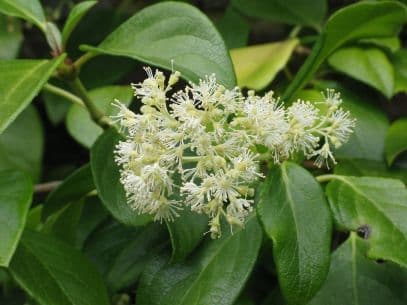
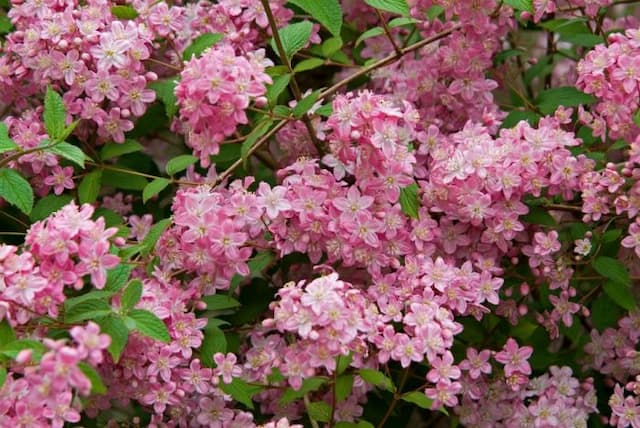
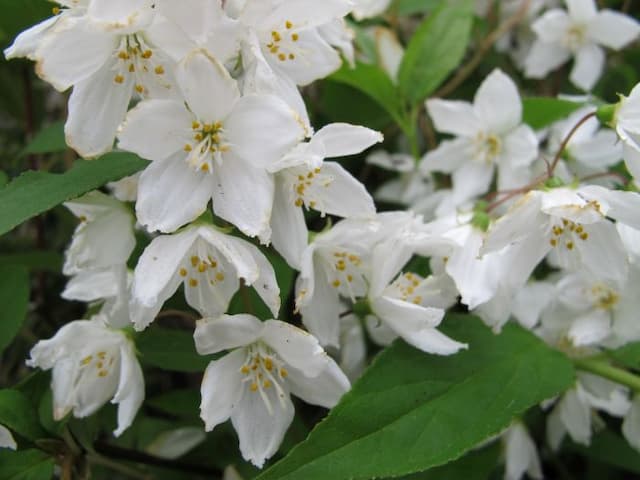
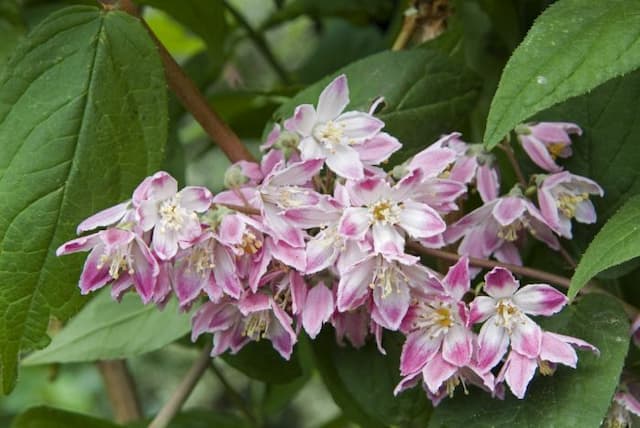

![Rose deutzia [Yuki Cherry Blossom]](/_next/image?url=https%3A%2F%2Fplants-admin.emdemapps.com%2Fimages%2Fplants%2F%2Fimages%2F604b6510a383a.png&w=640&q=75)
![Hydrangea [Hot Chocolate]](/_next/image?url=https%3A%2F%2Fplants-admin.emdemapps.com%2Fimages%2Fplants%2F%2Fimages%2F604b5a066e3bd.png&w=640&q=75)
![Hydrangea [Blackberry Pie]](/_next/image?url=https%3A%2F%2Fplants-admin.emdemapps.com%2Fimages%2Fplants%2F%2Fimages%2F604b56e2abc1d.png&w=640&q=75)
